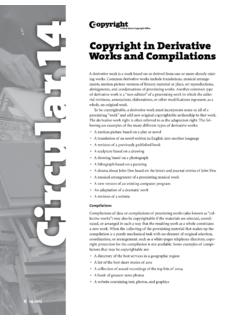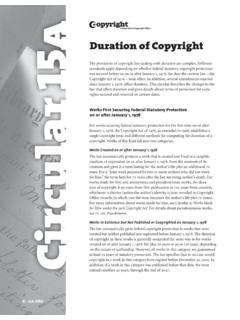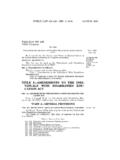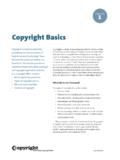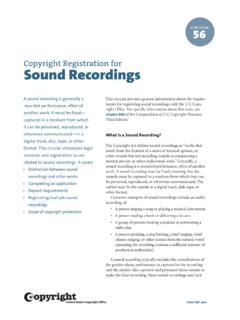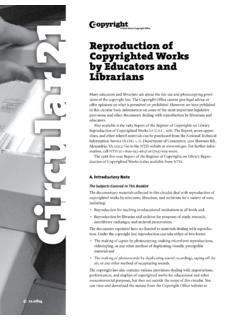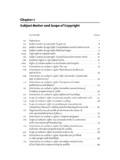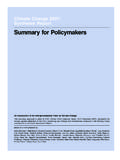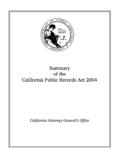Transcription of The Digital Millennium Copyright Act of 1998
1 Pub. L. No. 105-304, 112 Stat. 2860 (Oct. 28, 1998).1 Copyright Office SummaryDecember 1998 Page 1 THE Digital Millennium Copyright ACT OF Copyright Office SummaryDecember 1998 INTRODUCTIONThe Digital Millennium Copyright Act (DMCA) was signed into law by1 President Clinton on October 28, 1998. The legislation implements two 1996 WorldIntellectual Property Organization (WIPO) treaties: the WIPO Copyright Treaty andthe WIPO Performances and Phonograms Treaty. The DMCA also addresses anumber of other significant Copyright -related DMCA is divided into five titles: !
2 Title I, the WIPO Copyright and Performances and PhonogramsTreaties Implementation Act of 1998, implements the WIPO treaties.!Title II, the Online Copyright Infringement Liability LimitationAct, creates limitations on the liability of online service providers forcopyright infringement when engaging in certain types of activities.!Title III, the Computer Maintenance Competition AssuranceAct, creates an exemption for making a copy of a computer programby activating a computer for purposes of maintenance or repair.
3 !Title IV contains six miscellaneous provisions, relating to thefunctions of the Copyright Office, distance education, the exceptionsin the Copyright Act for libraries and for making ephemeral recordings, webcasting of sound recordings on the Internet, and the applicabilityof collective bargaining agreement obligations in the case of transfersof rights in motion pictures.!Title V, the Vessel Hull Design Protection Act, creates a new formof protection for the design of vessel memorandum summarizes briefly each title of the DMCA.
4 It providesmerely an overview of the law s provisions; for purposes of length and readability asignificant amount of detail has been omitted. A complete understanding of anyprovision of the DMCA requires reference to the text of the legislation Digital Millennium Copyright Act of 1998 Copyright Office SummaryDecember 1998 Page 2 TITLE I: WIPO TREATY IMPLEMENTATIONT itle I implements the WIPO treaties. First, it makes certain technicalamendments to law, in order to provide appropriate references and links to thetreaties.
5 Second, it creates two new prohibitions in Title 17 of the Code one oncircumvention of technological measures used by Copyright owners to protect theirworks and one on tampering with Copyright management information and adds civilremedies and criminal penalties for violating the prohibitions. In addition, Title Irequires the Copyright Office to perform two joint studies with the NationalTelecommunications and Information Administration of the Department ofCommerce (NTIA).
6 Technical AmendmentsNational EligibilityThe WIPO Copyright Treaty (WCT) and the WIPO Performances andPhonograms Treaty (WPPT) each require member countries to provide protection tocertain works from other member countries or created by nationals of other membercountries. That protection must be no less favorable than that accorded to 104 of the Copyright Act establishes the conditions of eligibility forprotection under law for works from other countries. Section 102(b) of theDMCA amends section 104 of the Copyright Act and adds new definitions to section101 of the Copyright Act in order to extend the protection of law to those worksrequired to be protected under the WCT and the of Copyright ProtectionBoth treaties require parties to protect preexisting works from other membercountries that have not fallen into the public domain in the country of origin throughthe expiry of the term of protection.
7 A similar obligation is contained in both theBerne Convention and the TRIPS Agreement. In 1995 this obligation was imple-mented in the Uruguay Round Agreements Act, creating a new section 104A in theCopyright Act to restore protection to works from Berne or WTO member countriesthat are still protected in the country of origin, but fell into the public domain in theUnited States in the past because of a failure to comply with formalities that thenexisted in law, or due to a lack of treaty relations.
8 Section 102(c) of the DMCA amends section 104A to restore Copyright protection in the same circumstances toworks from WCT and WPPT member Digital Millennium Copyright Act of 1998 Copyright Office SummaryDecember 1998 Page 3 Registration as a Prerequisite to SuitThe remaining technical amendment relates to the prohibition in both treatiesagainst conditioning the exercise or enjoyment of rights on the fulfillment offormalities. Section 411(a) of the Copyright Act requires claims to Copyright to beregistered with the Copyright Office before a lawsuit can be initiated by the copyrightowner, but exempts many foreign works in order to comply with existing treatyobligations under the Berne Convention.
9 Section 102(d) of the DMCA amends section411(a) by broadening the exemption to cover all foreign Protection and Copyright Management SystemsEach of the WIPO treaties contains virtually identical language obligatingmember states to prevent circumvention of technological measures used to protectcopyrighted works, and to prevent tampering with the integrity of copyrightmanagement information. These obligations serve as technological adjuncts to theexclusive rights granted by Copyright law.
10 They provide legal protection that theinternational Copyright community deemed critical to the safe and efficient exploitationof works on Digital of Technological Protection MeasuresGeneral approachArticle 11 of the WCT states:Contracting Parties shall provide adequate legal protec-tion and effective legal remedies against the circumven-tion of effective technological measures that are usedby authors in connection with the exercise of theirrights under this Treaty or the Berne Convention andthat restrict acts, in respect of their works, which arenot authorized by the authors concerned or permittedby 18 of the WPPT contains nearly identical language.
